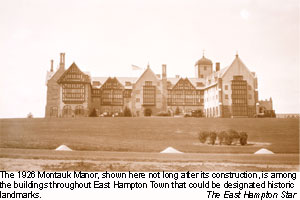Look for Ways to Save Landmarks- Consultant suggests how to preserve small houses and tall towers

Having already established historic districts on Main Street and Bluff Road in Amagansett, in Springs, and around the Association houses in Montauk, officials have turned their attention to the protection of historic buildings more widely scattered throughout East Hampton Town.
Buildings associated with farming in East Hampton and cattle grazing in Montauk, with the town's resort economy and its maritime and military pasts, and with Carl Fisher's attempted development of a "Montauk Beach" resort in the 1920s, have been listed in a draft report by Robert Hefner, a historic-preservation consultant to the town.
The report mentions 166 properties in all, including a number of private houses that date from the 18th and 19th centuries.
Mr. Hefner, who presented the report to the town board on Tuesday, compiled the list from previous surveys. He plans to inspect them to assess their present condition and to determine if they are still historically significant. Those that are could be included in a town "inventory of cultural resources" and protected in several ways, Mr. Hefner told the board.
The properties should be added to the Community Preservation Fund list, he said, so that money from the fund, which is earmarked for preservation of open space, farmland, and historic resources, could be used to buy them outright or to obtain protective easements.
The fund has already been used to buy and preserve a portion of the old Duck Creek Farm, six acres on Three Mile Harbor Road in Springs that contains the 1790s John Edwards house, to obtain farmland and historic easements on the Schellinger Farm property in Amagansett, and to buy a protective easement on the privately owned former Conklin house on Accabonac Road in East Hampton.
Mr. Hefner suggested several levels of "legislative protection" the board could adopt for historic properties.
One would be a "cultural resources overlay district." If a building permit was issued in this district, the town would be notified in time to record any historic features that would be eliminated or to suggest an alternative to demolition.
Another option would be designating sites as historic landmarks, which would limit how they could be changed and require a review of the work to be done.
Mr. Hefner noted that the owners of property in a historic district benefit financially, in that the character of their neighborhood is protected. On the other hand, owners of individual landmarks would be asked to protect their houses "for the benefit of the town as a whole," accepting restrictions without necessarily enjoying the benefits of seeing their neighbors' property being restricted as well. So they should be compensated in some way, he said.
The board will consider the idea of paying property owners for easements that preserve important interior features, providing grants for certified rehabilitation work or for returning a building to its historic form, and simply buying historic houses to use in the town's affordable housing program.
While the houses of the "wealthy landowners" in the hamlets' Main Streets have received attention and are often in the established historic districts, "just as important to the history of East Hampton and to the overall historic landscape are the scattered small houses of fishermen, subsistence farmers, and farm laborers," Mr. Hefner wrote in his memo to the board.
"East Hampton is one of the few places where so many of these little historic houses survive. These are an unstudied group of historic houses that represent a large class of East Hampton's early residents who receive little attention in our histories."
The small buildings have historically served as affordable housing, and many are still occupied by "local families with deep roots here," Mr. Hefner wrote.
However, there is a growing tendency for those families to sell their property and move elsewhere, leaving the small houses to second-home owners who tear them down or enlarge or remodel them, destroying their historic integrity.
To avoid that, Mr. Hefner suggested establishing a "small house program."
Owners of single-family residences that have been deemed historic landmarks might grant a historic easement to the town protecting the interior and frame and limiting expansion to 2,000 square feet.
In exchange, they would be given the right to build a second small house of up to 1,500 square feet on their property. The second house could, through rental or town purchase, become part of the affordable housing stock.
Town Supervisor Bill McGintee said Tuesday that protecting individual historic sites is something the board should move on "with some haste." He noted that pieces of Hampton history - the military bunkers in Montauk, for instance - were assets that could even draw some tourists.
The board agreed to develop legislation for discussion at a public hearing.
